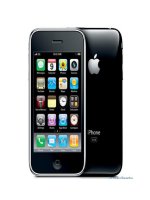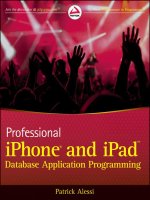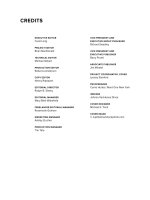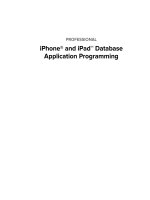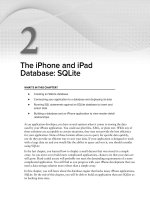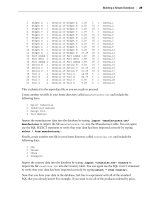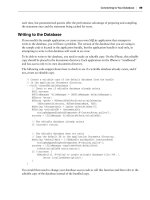Phát triển ứng dụng cho iPhone và iPad - part 26 docx
Bạn đang xem bản rút gọn của tài liệu. Xem và tải ngay bản đầy đủ của tài liệu tại đây (2.46 MB, 10 trang )
Core Data – Related Cocoa
Features
WHAT ’ S IN THIS CHAPTER?
Setting and getting data using key - value coding
Implementing a loosely coupled application architecture with
messaging and key - value observing
Creating predicates in several ways and using them to fi lter data
Building sort descriptors to order your data structures
In the last three chapters, you learned about the fundamentals of the Core Data
architecture — how to model your data and how to build a complete data - centric
application using the Core Data framework. This chapter provides a more detailed look at
some of the Cocoa functionality that you used with Core Data. In addition to their
application in Core Data, you can use these features in other interesting ways.
In this chapter, you learn more about some important Cocoa technologies: key - value coding,
key - value observing, predicates, and sort descriptors.
While you have seen these features used with Core Data, they are an integral part of the
Cocoa framework. You can use these concepts and their associated classes in ways that reach
far beyond Core Data. For example, you can use predicates and the
NSPredicate class to fi lter
and query regular Cocoa data structures such as arrays and dictionaries. You can develop
loosely coupled, message - based application architectures using the concepts of key - value
coding and key - value observing. Adding a deeper knowledge of these Cocoa features will
broaden your knowledge of the development platform and provide you with more tools for
your developer toolbox.
➤
➤
➤
➤
8
CH008.indd 219CH008.indd 219 9/20/10 3:02:20 PM9/20/10 3:02:20 PM
220
❘
CHAPTER 8 CORE DATA–RELATED COCOA FEATURES
KEY - VALUE CODING
You have already seen key - value coding, also referred to as KVC, in previous chapters. When you
used Core Data with an
NSManagedObject directly, instead of using an NSManagedObject custom
subclass, you used KVC to set and get the attribute values stored in the
NSManagedObject . KVC
allowed you to get and set the attributes of the managed object by name instead of using properties
and accessor methods.
The term “ key - value coding ” refers to the
NSKeyValueCoding protocol. This informal protocol
specifi es a way to access an object ’ s properties using a name or key rather than by calling the
accessor method directly. This capability is useful when you are trying to write generic code
that needs to operate on different properties of different objects. For example, in Chapter 7, you
designed the
EditTextController as a generic controller that you can use to provide a text - editing
capability. If you recall, you used this controller class to edit text attributes with different names
in two different objects. The
EditTextController used KVC to specify the appropriate text fi eld
name for the object that you wanted to edit.
Keys and Keypaths
Keys are the strings that you use to reference the properties of an object. The key is generally also
the name of the accessor method used to access the property.
Properties and accessor methods are closely related. When you type
@property NSString* name ,
you are telling the Cocoa framework to create accessor methods for the
name property for you. The
@synthesize directive that you use in your implementation fi le causes Cocoa to actually create
the methods. The framework automatically creates the
- (NSString*)name getter method and the
- (void) setName:(NSString*)newName setter method. You can choose to override one or both of
these methods if the default implementation does not meet your needs. It is a general standard that
property names start with a lowercase letter.
To get a specifi c value from an object using KVC, you call the
- (id)valueForKey:(NSString
*)key
method. This method returns the value in the object for the specifi ed key. The valueForKey
method returns the generic
id type. This means that it can return any Objective - C object type,
which makes KVC ideal for writing generic code. The method is unaware of the type of object that
it will return and can therefore return any type.
If an accessor method or instance variable with the key does not exist, the receiver
calls the
valueForUndefinedKey: method on itself. By default, this method throws an
NSUndefinedKeyException , but you can change this behavior in subclasses.
Instead of passing a simple key, there are alternate
methods that allow you to use keypaths to traverse
a set of nested objects using a dot - separated string.
In the example in the previous chapter, you used
keypaths to access a
Task ’ s Location ’ s name
property. When addressing a
Task object, you used
the keypath
location.name to get to the name
property from the
location attribute of the Task
object (see Figure 8 - 1).
FIGURE 8 - 1: Accessing a value with a keypath
Task
text
location
Location
.location
.name
name
CH008.indd 220CH008.indd 220 9/20/10 3:02:24 PM9/20/10 3:02:24 PM
The fi rst key in the keypath refers to a fi eld in the receiver of the call. You use subsequent keys to
drill down into the object returned by the fi rst key. Therefore, when used with a
Task object, the
keypath
location.name gets that Task ’ s location property and then asks that object for its name
property. As long as keys in the keypath return references to objects, you can drill down as deeply
into an object hierarchy as you wish.
You can use key - value coding to retrieve values from an object using a keypath instead of a simple
string key by calling the
- (id)valueForKeyPath:(NSString *)keyPath method. This works
like
valueForKey in that it returns the value at the given keypath. If anywhere along the keypath a
specifi ed key does not exist, the receiver calls the
valueForUndefinedKey: method on itself. Again,
this method throws an
NSUndefinedKeyException , and you can change this behavior in subclasses.
Finally, the
- (NSDictionary *)dictionaryWithValuesForKeys:(NSArray *)keys method can
be used for bulk retrieval of values using KVC. This method accepts an
NSArray of keys and returns
an
NSDictionary with the keys as the keys in the dictionary and the values returned from the object
as the values.
Setting Values Using Keys
Just as you can retrieve values from an object using KVC, you can set values using KVC. You
call the
- (void)setValue:(id)value forKey:(NSString *)key method to set the value for a
specifi ed key. If an accessor method or instance variable with the key does not exist, the receiver
calls the
setValue:forUndefinedKey: method on itself. By default, this method throws an
NSUndefinedKeyException , but you can change this behavior in subclasses.
You can also use a keypath to set a value in a target object using the
- (void)setValue:(id)value
forKeyPath:(NSString *)keypath
method. If any value in the keypath returns a nil key, the
receiver calls the
setValue:forUndefinedKey: method on itself. Again, this method throws an
NSUndefinedKeyException , but you can change this behavior in subclasses.
You can set a group of values in an object using KVC by calling the
- (void)setValuesForKeys
WithDictionary:(NSDictionary *)keyedValues
method. This method sets all of the values on
all of the key objects given in the dictionary. Behind the scenes, this method simply calls
setValue:
forKey:
for each item in the dictionary.
Collection Operators
If your object contains an array or set property, it is possible to perform some functions on the
list. You can include a function in the key path in a call to
valueForKeyPath . These functions are
called collection operators . You call collection operators using the form
pathToArray.@function
.pathToProperty
.
The functions that you can use in a collection operator are:
@avg : Loops over each item in the collection, converts its value to a double and returns an
NSNumber representing the average
@count : Returns the number of objects in the collection
➤
➤
Key-Value Coding
❘
221
CH008.indd 221CH008.indd 221 9/20/10 3:02:25 PM9/20/10 3:02:25 PM
222
❘
CHAPTER 8 CORE DATA–RELATED COCOA FEATURES
@distinctUnionOfArrays : Returns an array containing the unique items from the arrays
referenced by the keypath
@distinctUnionOfObjects : Returns the unique objects contained in the property
@max and @min : Return the maximum and minimum values respectively of the specifi ed
property
@sum : Loops over each item in the collection, converts its value to a double , and returns an
NSNumber representing the sum
@unionOfArrays , @unionOfObjects , and @unionOfSets: Function just like their distinct
counterparts except they return all items in the collection, not just unique items
For further information on using these functions, see Apple ’ s Key - Value Coding Programming
Guide, which is included as part of the Xcode documentation set.
Additional Considerations When Using KVC
It makes no difference if you access the properties
of a class by using the dot syntax, calling the
accessor method, or by using KVC. You can see
this illustrated in Figure 8 - 2. You are calling the
receiver ’ s accessor method either way. You should
be aware, however, that because there is an added
level of indirection when using KVC, there is a slight
performance hit. The performance penalty is very
small, so you should not let this deter you from using
KVC when it helps the fl exibility of your design.
When building your own classes, you should
pay attention to the naming conventions used by the Cocoa framework. Doing so helps to ensure
that your classes will be key - value coding – compliant. For example, the correct format for accessor
methods is
- var for the getter and - setVar for the setter. Defi ning properties in your classes
ensures that the accessor methods generated by the framework will be KVC - compliant.
There are additional rules for ensuring KVC compliance when your classes contain To - One or To - Many
relationships. You should consult the Key Value Coding Programming Guide in the Apple docs for more
detail on ensuring KVC compliance.
The
valueForKey: and setValue:forKey: methods automatically wrap scalar and struct data
types in
NSNumber or NSValue classes. So, there is no need for you to manually convert scalar types
(such as
int or long ) into Objective - C class types (such as NSNumber ); the framework will do it for
you automatically.
KEY - VALUE OBSERVING
In addition to obtaining property values using strings, you can take advantage of the
NSKeyValueCoding protocol to implement another very powerful feature in Cocoa, key - value
observing (or KVO). Key - value observing provides a way for objects to register to receive
➤
➤
➤
➤
➤
FIGURE 8 - 2:
Accessing a value using di erent
semantics
Task
text
location
taskObject.text
[taskObject text]
[taskObject valueForKey:@“text”]
CH008.indd 222CH008.indd 222 9/20/10 3:02:26 PM9/20/10 3:02:26 PM
notifi cations when properties in other objects change. A key architectural feature of this
functionality is that there is no central repository or server that sends out change notifi cations.
When implementing KVO, you link observers directly to the objects that they are observing without
going through an intermediary server. If you need to implement a centrally stored publish/subscribe
capability, the
NSNotification class provides this capability.
The base class for most Objective - C objects,
NSObject , provides the basic functionality of KVO. You
should generally not have to override the base class implementation in your own implementations.
Using KVO, you can observe changes to properties, To - One relationships and To - Many relationships.
By inheriting from
NSObject , the base class implements KVO automatically on your objects.
However, it is possible to disable automatic notifi cations or build your own manual notifi cations.
Observing Changes to an Object
To receive notifi cations for changes to an object, you must register as an observer of the object. You
register your class as an observer by calling the
addObserver:forKeyPath:options:context:
method on the object that you want to observe.
The
Observer parameter specifi es the object that the framework should notify when the observed
property changes. The
KeyPath parameter specifi es the property that you want to observe. Changes
to this property will cause the framework to generate a notifi cation. The
options parameter
specifi es if you want to receive the original property value (
NSKeyValueObservingOptionOld ) or
the new property value (
NSKeyValueObservingOptionNew ). You can receive both if you pass in
both
NSKeyValueObservingOptionOld and NSKeyValueObservingOptionNew using the bitwise
OR operator. The
context parameter is a pointer that the observed object passes back to the
observer when a change occurs.
When the property that you are observing changes, the observer will receive a notifi cation.
Notifi cations come back to the observer through calls to the observer ’ s
observeValueForKeyPath:
ofObject:change:context:
method. The observed object calls this method on the observer when
an observed property changes. Therefore, all observers must implement
observeValueForKeyPath:
ofObject:change:context:
to receive KVO callbacks. You can see the relationship between the
two objects along with the methods used to set up the relationship in Figure 8 - 3.
FIGURE 8 - 3: The KVO relationship
Observing Object
Observed Object
addObserver:forKeyPath:options:context:
observeValueForKeyPath:ofObject:change:context:
Key-Value Observing
❘
223
CH008.indd 223CH008.indd 223 9/20/10 3:02:26 PM9/20/10 3:02:26 PM
224
❘
CHAPTER 8 CORE DATA–RELATED COCOA FEATURES
When the observed object calls observeValueForKeyPath:ofObject:change:context: , the
observer receives a reference to the object that changed. Also sent to the receiver are the keypath to
the property that changed, a dictionary that contains the changes, and the context pointer that you
passed in the call that set up the relationship.
The
NSDictionary that you receive in the callback contains information about the changes to the
observed object. Depending on the options that you specifi ed in the call to set up the observer,
the dictionary will contain different keys. If you specifi ed
NSKeyValueObservingOptionNew , the
dictionary will have an entry corresponding with the
NSKeyValueChangeNewKey key that contains
the new value for the observed property. If you specifi ed
NSKeyValueObservingOptionOld , the
dictionary will have an entry for the
NSKeyValueChangeOldKey key that contains the original value of
the observed property. If you specifi ed both options using a bitwise OR, both keys will be available
in the dictionary. The dictionary will also contain an entry for the
NSKeyValueChangeKindKey that
gives you more information describing what kind of change has occurred.
When you are no longer interested in observing changes on an object, you need to unregister your
observer. You accomplish this by calling the
removeObserver : forKeyPath : method on the observed
object. You pass the observer and the keypath to the property that the observer was observing. After
you make this call, the observer will no longer receive change notifi cations from the observed object.
Automatic and Manual Implementations of KVO
The NSObject base class provides an automatic key - value observing implementation for all classes
that are key - value coding compliant. You can disable automatic support for KVO for specifi c keys
by calling the class method
automaticallyNotifiesObserversForKey :. In order to disable
keys, you need to implement this method to return
NO for the specifi c keys that you do not want
the framework to automatically support.
You can implement manual KVO notifi cations for fi ner control of when notifi cations go out. This
is useful when you have properties that could change very often or when you want to batch many
notifi cations into one. First, you have to override the
automaticallyNotifiesObserversForKey :
method to return
NO for keys that you want to implement manually. Then, in the accessor for the
property that you want to manually control, you have to call
willChangeValueForKey : before you
modify the value, and
didChangeValueForKey : afterwards.
Key - Value Observing Example
Now that you are familiar with the concepts behind key - value coding and key - value observing, let ’ s
work through a simple example. The example will help to demonstrate how to use this functionality
in practice. In this example, you will implement an iPhone version of a baseball umpire ’ s count
indicator. Umpires use this device to keep track of balls, strikes, and outs.
The sample application will use KVC and KVO to decouple the data object (
Counter ) from the
interface (
UmpireViewController ). Even though this example is simplifi ed, it will demonstrate how
to use KVC and KVO to decouple your data objects from your interface. Keep in mind that this
example is somewhat contrived in order to demonstrate using the principals of KVO and KVC in an
application. You could easily implement this solution in many other, simpler ways, without using
KVO and KVC. The
UmpireViewController will use KVC to set the values for balls, strikes, and
CH008.indd 224CH008.indd 224 9/20/10 3:02:27 PM9/20/10 3:02:27 PM
outs in the Counter object. The UmpireViewController will also observe changes for these fi elds
and use the observation method to update the user interface.
Building the User Interface
The fi rst task is to create the user interface in Interface Builder. Start a
new project using the View - based Application template. Call your new
application Umpire.
You should lay the interface out as shown in Figure 8 - 4. Open the
UmpireViewController.xib interface fi le. Add three UIButton objects
to the interface and change their titles to “ balls, ” “ strikes, ” and “ outs. ”
Add three
UILabel objects, one above each button. Change the text in
each one to the number 0.
Next, you need to modify the
UmpireViewController.h header fi le to
add outlets for the UI controls and an action method that will handle the
action when the user taps on one of the buttons.
Open the
UmpireViewController.h header fi le. Add an instance
variable for each
UILabel inside the @interface declaration:
UILabel* ballLabel;
UILabel* strikeLabel;
UILabel* outLabel;
UmpireViewController.h
Next, add properties for the three labels:
@property (nonatomic, retain) IBOutlet UILabel* ballLabel;
@property (nonatomic, retain) IBOutlet UILabel* strikeLabel;
@property (nonatomic, retain) IBOutlet UILabel* outLabel;
UmpireViewController.h
Finally, add an action method that you will call when a user taps one of the buttons:
-(IBAction)buttonTapped:(id)sender;
Now you need to open the UmpireViewController.m implementation fi le. At the top, synthesize the
properties that you just declared in the header fi le:
@synthesize ballLabel,strikeLabel, outLabel;
Add a stub method for buttonTapped :
-(IBAction)buttonTapped:(id)sender {
NSLog(@”buttonTapped”);
}
FIGURE 8 - 4: Umpire
application user interface
Key-Value Observing
❘
225
CH008.indd 225CH008.indd 225 9/20/10 3:02:28 PM9/20/10 3:02:28 PM
226
❘
CHAPTER 8 CORE DATA–RELATED COCOA FEATURES
Now you need to go back into Interface Builder and connect your outlets and actions. Open the
UmpireViewController.xib interface fi le. Connect the ballLabel , strikeLabel , and outLabel
outlets of the File ’ s Owner to the appropriate label in the view. Next, wire up each button in the
interface to the
buttonTapped action of File ’ s Owner. Your user interface is complete. Save the fi le
and close Interface Builder.
Build and run the application. It should build successfully with no errors or warnings. In the iPhone
simulator, tap each button and verify that when you tap each button, you see the “ buttonTapped ”
message in the console log.
The Counter Data Object
Now that your user interface is set up and working correctly, you will build a data object to hold the
umpire data. Create a new class that is a subclass of
NSObject and call it Counter .
Open the
Counter.h header fi le. Add three NSNumber instance variables, one each for balls ,
strikes , and outs :
NSNumber* balls;
NSNumber* strikes;
NSNumber* outs;
Counter.h
Add property declarations for each of the instance variables:
@property (nonatomic, retain) IBOutlet NSNumber* balls;
@property (nonatomic, retain) IBOutlet NSNumber* strikes;
@property (nonatomic, retain) IBOutlet NSNumber* outs;
Counter.h
In the implementation fi le Counter.m , synthesize the properties:
@synthesize balls,strikes,outs;
You will be using this object in the UmpireViewController so you need to add a reference to the
Counter.h header fi le in the UmpireViewController.h header. Open the UmpireViewController.
h
header fi le and add an import statement to import the Counter.h header:
#import “Counter.h”
Also in the UmpireViewController.h header fi le, add a Counter instance variable:
Counter* umpireCounter;
CH008.indd 226CH008.indd 226 9/20/10 3:02:30 PM9/20/10 3:02:30 PM
Next, add a property called umpireCounter :
@property (nonatomic, retain) Counter* umpireCounter;
The umpireCounter variable will hold the instance of the Counter that you will use to keep track of
the ball and strike count.
Finally, in the
UmpireViewController.m implementation fi le, synthesize the new umpireCounter
property:
@synthesize umpireCounter;
Implementing Key - Value Observing
With the data object in place, you can now connect your View Controller to the data object using
key - value observing. Open the
UmpireViewController.m implementation fi le.
You need to initialize the
umpireCounter variable and set up the KVO observation in the
viewDidLoad method. Here is viewDidLoad :
- (void)viewDidLoad {
[super viewDidLoad];
Counter *theCounter = [[Counter alloc] init];
self.umpireCounter = theCounter;
// Set up KVO for the umpire counter
[self.umpireCounter addObserver:self
forKeyPath:@”balls”
options:NSKeyValueObservingOptionNew
context:nil];
[self.umpireCounter addObserver:self
forKeyPath:@”strikes”
options:NSKeyValueObservingOptionNew
context:nil];
[self.umpireCounter addObserver:self
forKeyPath:@”outs”
options:NSKeyValueObservingOptionNew
context:nil];
[theCounter release];
}
UmpireViewController.m
First, as usual, you call the superclass implementation of viewDidLoad to ensure that the object is
set up properly and ready for use. Next, you create an instance of a
Counter object and assign it to
the
umpireCounter property.
Key-Value Observing
❘
227
CH008.indd 227CH008.indd 227 9/20/10 3:02:31 PM9/20/10 3:02:31 PM
228
❘
CHAPTER 8 CORE DATA–RELATED COCOA FEATURES
The next section sets up the KVO observation for each of the balls , strikes , and outs properties
of the
Counter object. Let ’ s take a closer look at the call to set up the observer for the balls
property:
[self.umpireCounter addObserver:self
forKeyPath:@”balls”
options:NSKeyValueObservingOptionNew
context:nil];
Remember that Counter inherits the addObserver:forKeyPath:options:context: method
from
NSObject . You are calling this method to confi gure the UmpireViewController as an
observer of the
umpireCounter object. Therefore, you pass self in as the object that will be
the observer. This particular observer will be observing the
balls property of the umpireCounter ,
so you pass the string “ balls ” in for the keypath. You don ’ t really care what the old value of
balls is; you are only interested in the new value when the value changes so you pass the
NSKeyValueObservingOptionNew option in the method call. Finally, you set the context to nil
because you do not need context data.
Finally, in the
viewDidLoad method, you release the local variable theCounter because you
incremented its retain count when you assigned it to the
umpireCounter property.
Now that you ’ ve set up your code to become an observer, you need to implement the
observeValueForKeyPath:ofObject:change:context: method that the observed object calls
when observed properties change. Here is the method:
- (void)observeValueForKeyPath:(NSString *)keyPath
ofObject:(id)object
change:(NSDictionary *)change
context:(void *)context {
// change gives back an NSDictionary of changes
NSNumber *newValue = [change valueForKey:NSKeyValueChangeNewKey];
// update the appropriate label
if (keyPath == @”balls”) {
self.ballLabel.text = [newValue stringValue];
}
else if (keyPath == @”strikes”) {
self.strikeLabel.text = [newValue stringValue];
}
else if (keyPath == @”outs”) {
self.outLabel.text = [newValue stringValue];
}
}
UmpireViewController.m
Remember that every time any observed property in the umpireCounter changes, the
umpireCounter will call this method. The fi rst line retrieves the new value from the change
dictionary for the property that changed. Next, you examine the keypath that the
umpireCounter
CH008.indd 228CH008.indd 228 9/20/10 3:02:32 PM9/20/10 3:02:32 PM
